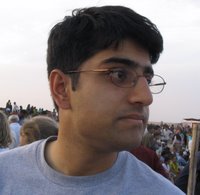"Red Fort is made of the red sandstone,"
"you know, is local to this part of India. Was start building in 1526 and complete in 1720. 40 million rupees were completed in this time." -Delhi tour guide
This was our guide's refrain. When we first saw him I thought he was a used car salesman. He wore a blue blazer with dark pants and some kind of leather shoes shaped like alligator snouts. Their slight upward curve reminded me of mojdi- except sleazier. His ensemble was incomplete without his stylish sunglasses, which kept his eyes hidden the entire time we were with him. I feel a bit uneasy when I can't look a stranger in the eyes. But he was very humorous.
We had to pass from New Delhi to old Delhi (about 15 km) and along the way he would stop at nothing to provide us with valuable information/guidance/history relating to the sights of India's capital. As we drove along the main highway he pointed left from his post at shotgun, and would say things like "Right is Red Fort," or "This round building on right is Parliament building," or "That building is where our Supreme Court of India meet." He was a stickler for detail.
When we finally got out of the car, we were outside of Rashtrapati Bhavan, the former palace of the Mughal Emperors that now houses India's president. The palace sits at one end of the capital complex and is flanked on both sides by beautiful buildings in mixed Mughal and colonial British style. A wide promenade stretches west to India Gate, a large structure that commemorates the Indians who died in the World Wars and the Afghan Wars. I was reminded of the capitol mall in D.C. Both areas are meticulously planned and set aside from the metropolitan areas they neighbor. Whereas in London, Parliament looks as if it were dropped from the sky onto a fully developed city block. And 10 Downing St. is right next to...well, 8 Downing St. probably.
The entire area is breathtaking, partly because it is so large, open and well maintained. It is a far cry from anything in Bombay. We later found out that the Gateway of India area of Bombay was supposed to be a sprawling area in the same style as the capital but the city government didn't want to promise so much land to the architect, in case his gate turned out an eyesore. By the time he finished the gate, the surrounding area had been sold to developers. So now his gate sits skewed from the rest of the area's grid, pointing to where its sister buildings were supposed to stand.
Our next destination was one of the most wonderful spots in Delhi. It is the oldest shopping and 'downtown' area in the old city and it's called Chandni Chowk. Chandni is star and Chowk means square. There are chowks everywhere but this one is unique. We hopped on a bicycle rickshaw and entered the smallest lanes I've ever seen. Inside the chowk the streets are wide enough for 2 bicycle rickshaws at most and with two-wheelers and foot traffic, they are some of the busiest streets anywhere . The most fun is when you are on a bike rick and you encounter another one coming in the opposite direction. First there is a gridlock and everyone gets annoyed. Then with some effort all the pedestrians duck into a shop front to make room as you slip past each other. You don't fear accidents here because traffic is one big accident. But everybody travels so slowly that most people don't get hurt. A westerner once famously said that if you don't believe in God you should see traffic in India and you'll be assured of His existence.
We passed whole blocks of sari shops with their brightest pinks, reds and saffrons hanging out front. Other blocks were occupied completely by silver merchants or gold merchants or puppet makers or sweetmeat shops. The neighborhood is magnificently old. Space is so precious in Chandni Chowk that all the wires required by our advanced age are suspended twenty feet above street level along each lane. With the ancient buildings sagging over the lanes, you feel confined to a system of tunnels where the outside world ceases to exist. It is said that if you can't find something for sale in Chandni Chowk it is probably not worth having. (There is generally at least one area of every ancient Indian city about which this same thing is said.)
On the southeast corner of Chandni Chowk sits Jama Masjid, the third largest mosque in the world and one of the oldest in India. "The Jama Masjid was built by first Mughal Emperor, Babar, was start in ... 20 million rupees were completed in that time," said Rakesh. We would soon figure out that short of the Taj Mahal, everything in Delhi and Agra was built out of "the red sandstone, you know, is local to this part of India," and a lot of rupees were completed in those times. We had to wait a bit to enter because afternoon prayers were about to begin. From the outside you wouldn't believe that it had a capacity of 20,000 but once you pass under the large Mughal arches, you enter a vast courtyard. At this point I had yet to develop an appreciation for the influence of Islam and also Middle Eastern culture on India. I still thought of them as unique phenomena that had a long history of contact. But as the trip continued I began to understand the adaptive and creative powers that have long been the law of this land.
See some pictures for this entry at my Flickr page.

